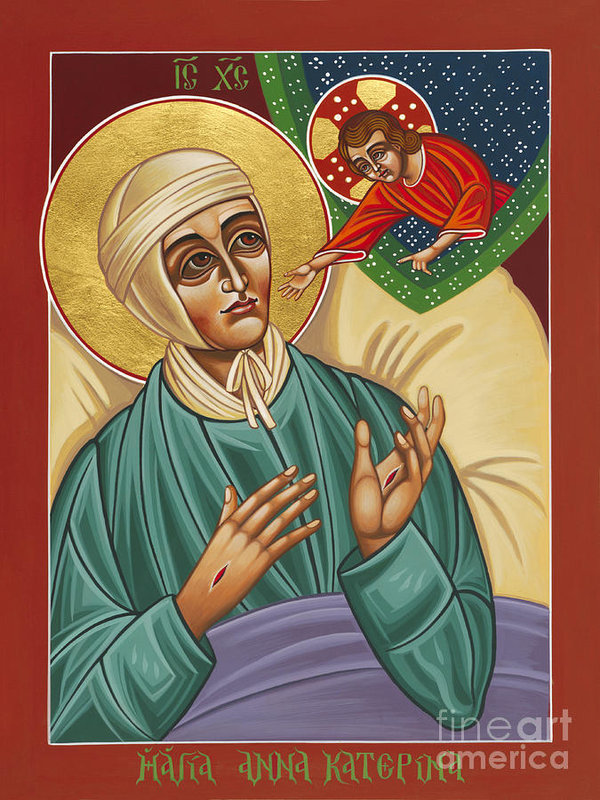Saint of the Day – 9 February – Blessed Anna Katharina Emmerick/Anne Catherine Emmerich (1774-1824) – Handicapped, Virgin, Religious, Penitent, Marian Visionary, Mystic, Ecstatic, Writer and Stigmatist. Her body is incorrupt.

Anna Katharina Emmerick was born on 8 September 1774 in the farming community of Flamsche near Coesfeld. She grew up amidst a host of nine brothers and sisters. She had to help out in the house and with the farm work at an early age. Her school attendance was brief, which made it all the more remarkable that she was well instructed in religious matters. Her parents and all those who knew Anna Katherina noticed early on that she felt drawn to prayer and to the religious life in a special way.
Anna Katharina laboured for three years on a large farm in the vicinity. Then she learned to sew and stayed in Coesfeld for her further training. She loved to visit the old churches in Coesfeld and to join in the celebration of Mass. She often walked the path of Coesfeld’s long Way of the Cross alone, praying the stations by herself. She wanted to enter the convent but since her wish could not be fulfilled at that time, she returned to her parental home. She worked as a seamstress and, while doing so, visited many homes.
Anna Katherina asked for admission to different convents but she was rejected because she could not bring a significant dowry with her. The Poor Clares in Münster finally agreed to accept her if she would learn to play the organ. She received her parents’ permission to be trained in Coesfeld by the organist Söntgen. But she never got around to learning how to play the organ. The misery and poverty in the Söntgen household prompted her to work in the house and help out in the family. She even sacrificed her small savings for their sake.
Together with her friend Klara Söntgen Anna Katharina was finally able to enter the convent Agnetenberg in Dülmen in 1802. The following year she took her religious vows. She participated enthusiastically in the life of the convent. She was always willing to take on hard work and loathsome tasks. Because of her impoverished background she was at first given little respect in the convent. Some of the sisters took offence at her strict observance of the order’s rule and considered her a hypocrite. Anna Katharina bore this pain in silence and quiet submission.
From 1802 to 1811 Anna Katharina was ill quite often and had to endure great pain.
As a result of secularisation the convent of Agnetenberg was suppressed in 1811 and Anna Katharina had to leave the convent along with the others. She was taken in as a housekeeper at the home of Abbé Lambert, a priest who had fled France and lived in Dülmen. But she soon became ill. She was unable to leave the house and was confined to bed. In agreement with Curate Lambert she had her younger sister Gertrud come to take over the housekeeping under her direction.
During this period Anna Katharina received the stigmata. She had already endured the pain of the stigmata for a long time. The fact that she bore the wounds of Christ could not remain hidden. Dr Franz Wesener, a young doctor, went to see her and he was so impressed by her that he became a faithful, selfless and helping friend during the following eleven years. He kept a diary about his contacts with Anna Katharina Emmerick in which he recorded a wealth of details.
A striking characteristic of the life of Anna Katharina was her love for people. Wherever she saw need she tried to help. Even in her sickbed she sewed clothes for poor children and was pleased when she could help them in this way. Although she could have found her many visitors annoying, she received all of them kindly. She embraced their concerns in her prayers and gave them encouragement and words of comfort.
Many prominent people who were important in the renewal movement of the church at the beginning of the 19th century sought an opportunity to meet Anna Katharina, among them Clemens August Droste zu Vischering, Bernhard Overberg, Friedrich Leopold von Stolberg, Johann Michael Sailer, Christian and Clemens Brentano, Luise Hensel, Melchior and Apollonia Diepenbrock. The encounter with Clemens Brentano was particularly significant. His first visit led him to stay in Dülmen for five years. He visited Anna Katharina daily to record her visions which he later published.
Anna Katharina grew ever weaker during the summer of 1823. As always she joined her suffering to the suffering of Jesus and offered it up for the salvation of all. She died on 9 February 1824. She was buried in the cemetery in Dülmen. A large number of people attended the funeral. Because of a rumour that her corpse had been stolen the grave was reopened twice in the weeks following the burial. The coffin and the corpse were found to be intact.
Clemens Brentano wrote the following about Anna Katharina Emmerick: “She stands like a cross by the wayside”. Anna Katharina Emmerick shows us the centre of our Christian faith, the mystery of the cross.
The life of Anna Katharina Emmerick is marked by her profound closeness to Christ. She loved to pray before the famous Coesfeld Cross and she walked the path of the long Way of the Cross frequently. So great was her personal participation in the sufferings of our Lord that it is not an exaggeration to say that she lived, suffered and died with Christ. An external sign of this, which is at the same time, however, more than just a sign, are the wounds of Christ which she bore.


Anna Katharina Emmerick was a great admirer of Mary. The feast of the Nativity of Mary was also Anna Katharina’s birthday. A verse from a prayer to Mary highlights a further aspect of Anna Katharina’s life for us. The prayer states, “O God, let us serve the work of salvation following the example of the faith and the love of Mary”. To serve the work of salvation – that is what Anna Katharina wanted to do.
In Colossians the apostle Paul speaks of two ways to serve the gospel, to serve salvation. One consists in the active proclamation in word and deed. But what if that is no longer possible? Paul, who obviously finds himself in such a situation, writes: “Now I rejoice in my sufferings for your sake and in my flesh I complete what is lacking in Christ’s afflictions for the sake of his body, that is, the church” (Col 1:24).
Anna Katharina Emmerick served salvation in both ways. Her words, which have reached innumerable people in many languages from her modest room in Dülmen through the writings of Clemens Brentano, are an outstanding proclamation of the gospel in service to salvation right up to the present day. At the same time, however, Anna Katharina Emmerick understood her suffering as a service to salvation. Dr Wesener, her doctor, recounts her petition in his diary: “I have always requested for myself as a special gift from God that I suffer for those who are on the wrong path due to error or weakness, and that, if possible, I make reparation for them.” It has been reported that Anna Katharina Emmerick gave many of her visitors religious assistance and consolation. Her words had this power because she brought her life and suffering into the service of salvation. In serving the work of salvation through faith and love, Anna Katharina Emmerick can be a model for us all.
Dr Wesener passed on this remark of Anna Katharina Emmerick: “I have always considered service to my neighbour to be the greatest virtue. In my earliest childhood I already requested of God that he give me the strength to serve my fellow human beings and to be useful. And now I know that he has granted my request.” How could she who was confined to her sickroom and her bed for years serve her highborn? (vatican.va)
Her Works: • The Dolorous Passion of Our Lord Jesus Christ
• The Life of Jesus Christ and Biblical Revelations
• The Lowly life and Bitter Passion of Our Lord Jesus Christ and His Blessed Mother
Anna was Beatified on 3 October 2004, by St Pope John Paul II. However, the Vatican focused on her own personal piety rather than the religious writings associated to her by Clemens Brentano. Her documents of postulation towards canonisation is handled by the Priestly Fraternity of St Peter. Father Peter Gumpel who was involved in the analysis of the matter at the Vatican told Catholic News Service: “Since it was impossible to distinguish what derives from Sister Emmerich and what is embroidery or additions, we could not take these writings as a criteria. Therefore, they were simply discarded completely from all the work for the cause”.
In 2003 actor Mel Gibson brought Anne Catherine Emmerich’s vision to prominence as he used her book The Dolorous Passion as a key source for his movie The Passion of the Christ. Gibson stated that Scripture and “accepted visions” were the only sources he drew on and a careful reading of Emmerich’s book shows the film’s high level of dependence on it.
In 2007 German director Dominik Graf made the movie The Pledge as a dramatisation of the encounters between Anne Catherine and Clemens Brentano, based on a novel by Kai Meyer.

House of the Virgin Mary

Neither Brentano nor Emmerich had ever been to Ephesus and indeed the city had not yet been excavated; but visions contained in The Life of The Blessed Virgin Mary were used during the discovery of the House of the Virgin Mary, the Blessed Virgin’s supposed home before her Assumption, located on a hill near Ephesus, as described in the book Mary’s House.
In 1881, a French priest, the Abbé Julien Gouyet used Emmerich’s book to search for the house in Ephesus and found it based on the descriptions. He was not taken seriously at first but sister Marie de Mandat-Grancey persisted until two other priests followed the same path and confirmed the finding.
The Holy See has taken no official position on the authenticity of the location yet but in 1896 Pope Leo XIII visited it and in 1951 Pope Pius XII initially declared the house a Holy Place. St Pope John XXIII later made the declaration permanent. Blessed Pope Paul VI in 1967, St Pope John Paul II in 1979 and Pope Benedict XVI in 2006 visited the house and treated it as a shrine.









One thought on “Saint of the Day – 9 February – Blessed Anna Katharina Emmerick/Anne Catherine Emmerich (1774-1824)”